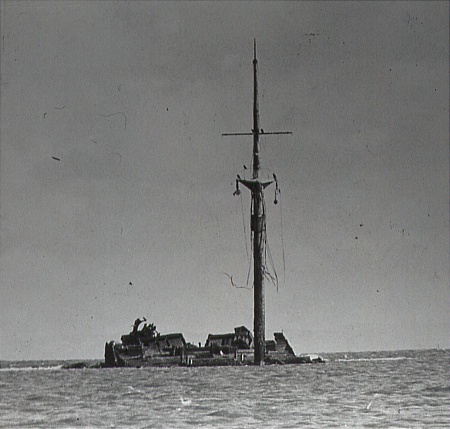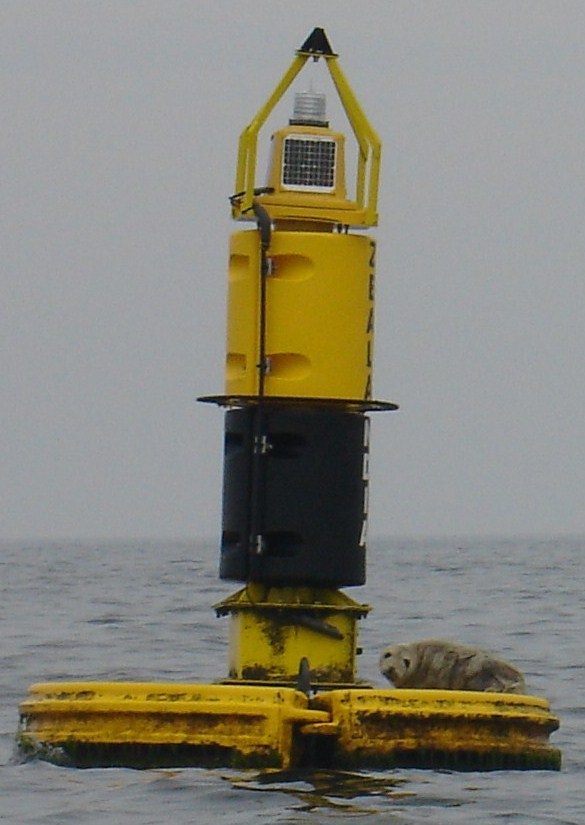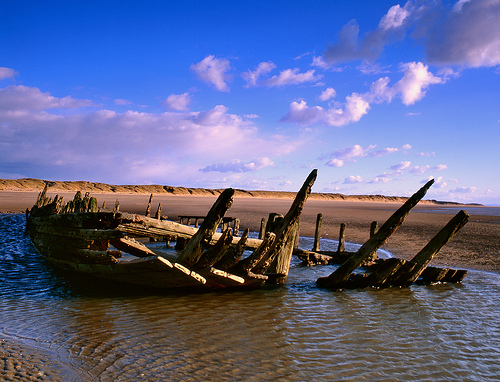These treacherous shores have seen a great many shipwrecks
Some estimates claim that over 400 vessels have come to grief, over recent centuries, on this 20 or so miles of coast and lay buried beneath the sands. When conditions are right and there is a big ebb-tide some wrecks reveal themselves fleetingly. It would be an impossible task to tell the harrowing stories of every shipwreck, or of the heroism of those who risked all in going to their aid; indeed sometimes there were no survivors left to tell the tale.
What I wish to do here is relate the story of just a few and let the images of this beautiful but wild stretch of coastline convey something of the desolation and horror which would have been the last memory of so many stricken sailors.
The Wreck of the Pegu
Remains of SS Pegu about a mile off Formby Point
The Pegu, an 8000 ton passenger and cargo vessel of the Henderson Line, foundered on 24 November 1939 and now lies at the low spring tide line. This means that for most of the year she is under water.
As a wartime measure the navigation lights on the buoys had been switched off. She lost her course and ran aground initially on the river revetment. The New Brighton lifeboat rescued all 103 passengers and crew before she later broke her back: it is the forward section of the ship which now lies at Mad Wharf.
Until 1987 she still bore her mast but this was lost when a tugboat herself in difficulties in a force 10 gale overran her.
Four more images of the Pegu


-Before 1987

Until 1987 she still bore her mast but this was lost when a tugboat herself in difficulties in a force 10 gale overran her.
Four more images of the Pegu

-Before 1987

Zealandia

The Zealandia buoy (and its occasional tenant) marks the hazard where the ship of this name ran aground on 2 April 1917.
The Zealandia, a 2730 ton iron clad steamer, was sailing from New York to Liverpool with a general cargo when she ran aground on Horsebank about 3 miles west of Southport pier. What remains of the ship, engine block and boilers, can still occasionally be seen; two of the crew of 47 were lost.
The Zealandia was one of the last wrecks to be attended by the Southport lifeboat before de-commisioning in 1925.
Loss of Pilot Boat and 22 Lives
This was the headline when the Liverpool Daily Post of 27 November 1939 ran the first news of this tragedy and some of the account which follows is an abstract of this report.
It later emerged that not 22 but 23 lives had been lost.

On 26 November 1939 the pilot boat Charles Livingston ran aground on the sands at Ainsdale at about 3.30 in the morning. Twenty three men died including seven pilots; ten were either rescued by the Blackpool lifeboat or managed, with the assistance of a shore team, to save themselves.
The circumstances of this disaster were particularly disturbing: there was a heavy sea running in a WSW gale and the crew sent out a Mayday stating that they were ashore somewhere between Great Orme's Head and the Bar Lightship.
After an exhaustive search involving the Rhyl, Hoylake and Blackpool No. 2 lifeboats nothing could be found on this stretch of the North Wales coast. It transpired that in the raging sea and with persistent squalls of rain the crew had lost sight of the Lightvessel which would have been their main navigational aid; for more than three hours they had steamed cautiously ahead trying to ascertain their position.
With first light and with waves crashing over them the surviving crew realised that they were actually aground on Ainsdale Sands. Earlier in the piece, the ship's oar boat had been launched with the apprentices on board but this almost immediately got into difficulties. The ship's two motor boats were then sent to lend assistance but all three were soon lost sight of; they were later found upturned on the beach with no survivors.
The remaining crew had stayed aboard clinging to the rigging. With waves running 20 feet high on an incoming tide it was not until 2 pm that six survivors were taken aboard the Blackpool lifeboat which had perilously navigated to the lee of the stricken vessel. Of the rest a small number had managed to get ashore but the others, including the captain, had been washed exhausted out of the rigging to their deaths.
The ship was just 500 yds from the shore.
Both the Lytham and Blackpool lifeboats had attended and crew members from each boat were awarded gallantry medals. At one point in the mountainous seas two crew members of the Blackpool boat Sarah Ann Austin were washed overboard but their fellow crew managed to save them.
Star of Hope
Martyn Griffiths, who has spent much time researching this subject and to whom I am indebted, describes the Star of Hope as archetypal of the many sailing vessels which have foundered on Sefton's shores.
She was German owned but of Scottish construction: a three masted barque 120 feet long by 25 feet wide, built in Peterhead in 1865.
Happily, in this case, the crew of nine realising their ship could not cope with the westerly gales and surging sea had all managed safely to get aboard the Crosby Lightship before abandoning the ship to her fate. Like the ill-fated pilot boat Charles Livingston she was driven aground on the Ainsdale shore. Here she still lies.
That same night the New Brighton lifeboat was launched in answer to several distress calls. When she was flipped over by a huge wave four crew were pitched into the sea. Three were rescued by their comrades but the fourth drowned leaving a wife and six children to mourn his loss.
The Russian vessel the Kuvus was blown ashore not far away in the same storm.
Images Star of Hope


The Star of Hope had been voyaging from Wilmington, North Carolina, with a cargo of cotton destined via Liverpool to the mill towns of Lancashire.
Southport and St Anne's Lifeboats Disaster
It is impossible to overestimate the courage of lifeboatmen who put out in the very worst of conditions to go to the aid of those in distress at sea or at the shore's edge. All Royal National Lifeboat Institution (RNLI) crew are unpaid volunteers yet when the occasion demands they willingly put their lives on the line. Most volunteers these days have regular jobs which are quite unconnected with the sea.
The most devastating lifeboats disaster in British waters took place on 9 December 1886 after the Mexico, a German barque, ran aground on Horsebank near Birkdale. The crew of twelve were all rescued by the Lytham lifeboat, the Charles Biggs, on this her maiden rescue mission. The lifeboats from Southport and St Anne's, however, each of which answered the call also, capsized.
Accounts of the two survivors of the Eliza Fernley from Southport report that she had got close enough to the Mexico to throw a line before the crashing sea first turned her broadside before turning her over completely trapping most of the crew.
Quite how the Laura Janet of St Anne's became submerged is not known since none of the crew survived. At noon the following day the wrecked boat without anchor, mast or sails was discovered on the Birkdale shore. In all 27 lifeboatmen were lost: 14 from Southport and 13 from St Anne's.
The two survivors from the Southport boat, Henry Robinson and John Jackson, managed to swim ashore before walking to their homes and raising the alarm.
News of the tragedy touched the nation and within two weeks a fund of £30,000 pounds was raised for the relief of the sixteen widows and fifteen orphans. Queen Victoria and Kaiser Wilhelm I both made personal contributions.
 Illustration of the capsized Eliza Fernley
Illustration of the capsized Eliza Fernley The Mexico
The MexicoThe Mexico was salvaged and repaired and even achieved a return voyage to the Falkland Islands before in 1890 she was finally lost off the coast of Scotland.
Attributions:
The more recent photographs I have found from web research. To any who recognize these images as their own I extend my thanks. It is unclear to me who the authors are.
Link:
http://plus.google.com/+ColinMcIndoecolmacro48/posts
No comments:
Post a Comment